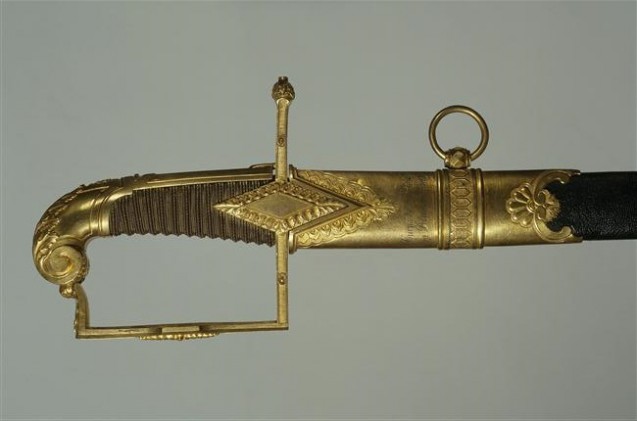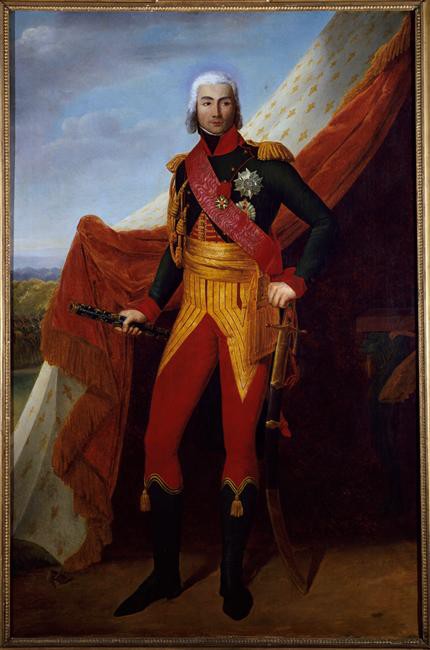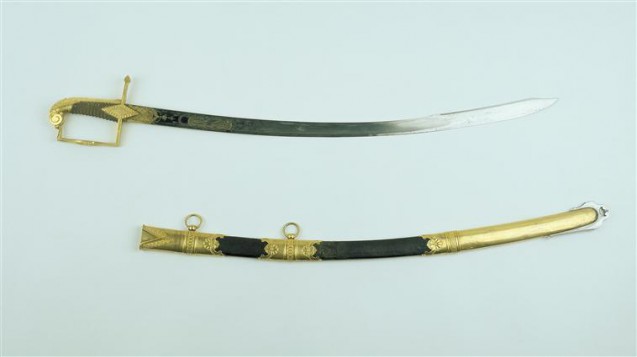Weapons of honour
In 1791 the National Constituent Assembly disposed of royal military honours and replaced them with their own Décoration Militaire. Then, on 21 September 1792, the Convention abolished the monarchy and with it the Décoration Militaire (officially abolished on 15 October 1792), which was in effect a direct descendent of the Ancien Régime. The following years of conflict between the Revolutionary armies and those of the European monarchs (grouped under the First Coalition) changed the Convention’s perspective. Taking their inspiration from the Gallo-Romans, they gave the army permission to reinstate the traditional practice of granting weapons of honour for outstanding military achievement. From then on weapons of honour were gradually brought back into mainstream military practice, bolstered by the decision of Bonaparte to add a provision to the ordre du jour of Passeriano 11 Fructidor (28 August 1797) to increase the number to be bestowed upon his soldiers.
The distribution of weapons of honour was then firmly established during the Egyptian campaign and made official by the Consulate with the law of 4 Nivôse An VIII (25 December 1799). All soldiers who distinguished themselves with outstanding military action could hope for a decoration, according to their unit. Rifles and sabres-briquets[1] were awarded to grenadiers and the line infantry, pistols were given to officers, drumsticks to drummers, trumpets for trumpeters, mousquetons[2] and rifles for the cavalry troops, grenades for the gunners with the most skilful aim, and fouets d’honneur (honorary riding crops) for the drivers of the artillery train. Each of these weapons would be inscribed and/or hilted or garnished in silver or gold.
Description of the Sabre
The sabre is 98 cm in length and 13.7 cm in width, and has an inscription on the handle: ‘Day of Saint Cloud, 19 Brumaire of the Year VIII.’ It was awarded to Jean-Baptiste Bessières by First Consul Napoleon Bonaparte for his role in protecting the general during the events of 19 Brumaire. His actions at Brumaire also earned him the title of Commander in Chief of the Cavalerie de la Garde Consulaire that same night.

© Paris – Musée de l’Armée, Dist. RMN-Grand Palais – Pascal Segrette
The sabre was made in Nicolas-Noël Boutet’s arms manufactory at Versailles and was the first in a long series of awards and honours Bessières would receive during the course of his military career. He would go on to become Marshal of the Empire, Commander of the Cavalry of the Garde Impériale (19 May 1804), Grand-Aigle of the Légion d’honneur (2 February 1805), and Duc d’Istrie (28 May 1809).
Jean-Baptiste Bessières was born on 6 August 1768 in Prayssac, a small village in the Lot region of France. He was the son of a respected surgeon and expected to follow in his father’s footsteps, but the upheaval of the Revolution led him toward a career in the military, and he enlisted as a soldier of the Constitutional Guard in 1792. After a number of promotions and transfers, he enrolled in the Paris National Guard in July and, moved by the plight of Louis XVI, did all he could to defend the king during the Insurrection of 10 August 1792. He was forced into hiding for a short while after the fall of the monarchy, but soon resumed his military service in the 22nd Regiment of the Chasseurs à Cheval.
Bessières rapidly climbed the military ranks, participating as a captain in the war against Spain between 1794 and 1795. He transferred to the Army of Italy in 1796, where he was quick to distinguish himself and was named Captain of the Guides de l’Armée by General Bonaparte. The Guides de l’Armée was an elite unit that later became the heart of the Consular and Imperial Guard. Bessières went from glory to glory, first at Roveredo (4 September 1796), at Rivoli (14-15 January 1797) and then La Favorite, which caught the attention of the General in Chief. Bessières was to remain in the Guard (in its various manifestations) and would therefore spend the rest of his career in close proximity to its leader, Napoleon Bonaparte.
Over time, Bessières became a faithful friend to Bonaparte. The general in return gave him the honour of accompanying the conquered Austrian flags, won during the Italian campaign, back to Paris. Bessières then joined the Egyptian campaign, where he excelled during the siege of Saint-Jean d’Acre (20 March-21 May 1799) and at the Battle of Aboukir (25 July 1799). He stuck close to Bonaparte, returning with him to France in August 1799, where he was soon to participate in the coup of Brumaire.
When General Bonaparte became First Consul of the Republic he awarded Bessières with the position of Commander in Chief of the Cavalry of the Guard, and presented him with the sabre here.
After gaining yet more glory during the Battle of Marengo on 14 June 1800, Bessières was named Général de Brigade on 18 July, and then Général de Division on 13 September 1802. He was made Marshal of the Empire on 19 May 1804, and Grand Officer of the Légion d’Honneur in June the same year. He was active in the German campaign of 1805 and defeated Tsar Alexander’s army (commanded by Prince Repnine) as head of the Cavalry of the Imperial Guard.

© RMN-Grand Palais – Agence Bulloz
He went on to serve at Jena, Eylau, and Friedland and was given command of a unit of the army in Spain in 1808. During this time he was dedicated in his efforts to defend King Joseph, with the Emperor even going so far as to proclaim that it was ‘Bessières [who] put [his] brother Joseph on the throne of Spain’. He was then sent on the campaign of Germany and Austria in 1809, where on 6 July, his horse was shot from underneath him and killed by an Austrian cannon ball. He was given the title of Duke of Istria in the same year and sent back to Spain in 1811, where he had to face a set of difficult professional circumstances and a particularly brutal form of asymmetrical warfare.
After requesting a transfer, he received orders to take part in the Russian campaign in 1812. He believed the invasion of Russia to be a step too far, but could not persuade the Emperor to give up his attempt to force Alexander I into alliance. Bessières’s fears became a reality during the retreat from Moscow, during which he saved the Emperor from 8,000 Cossack soldiers charging towards him. He was then immediately sent to Germany for the Saxon campaign, leading what remained of the Cavalry of the Guard. On 1 May 1813, his glorious career was brought to an end at the Battle of Lützen, where he was killed by a Russian cannon ball.
In exile on St Helena, the Emperor remarked that Bessières had ‘lived like Bayard and died like Turenne.’
[1] A sabre-briquet was a sword used by the infantry of the French army from the second half of the 18th Century. It was designed to be less cumbersome than earlier models of sword used during the Ancien Regime.
[2] A musketoon – a short-barrelled musket.
Author: Eymeric Job (Translation PH and JR)


